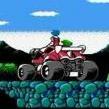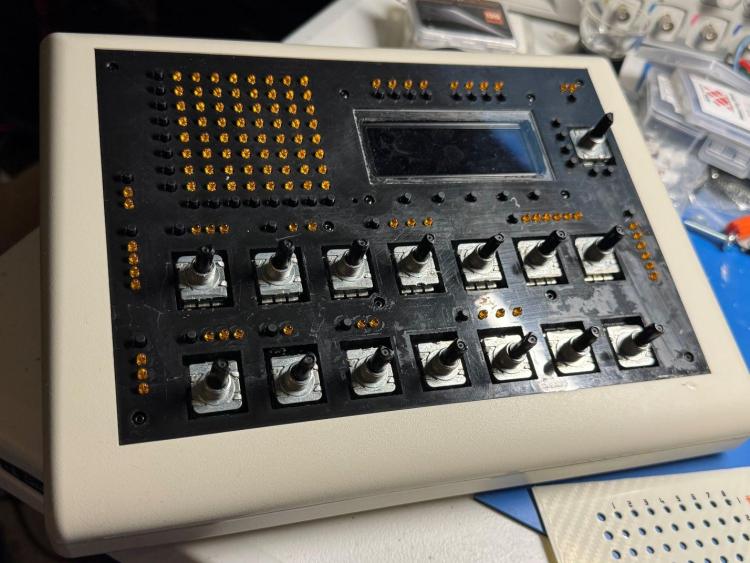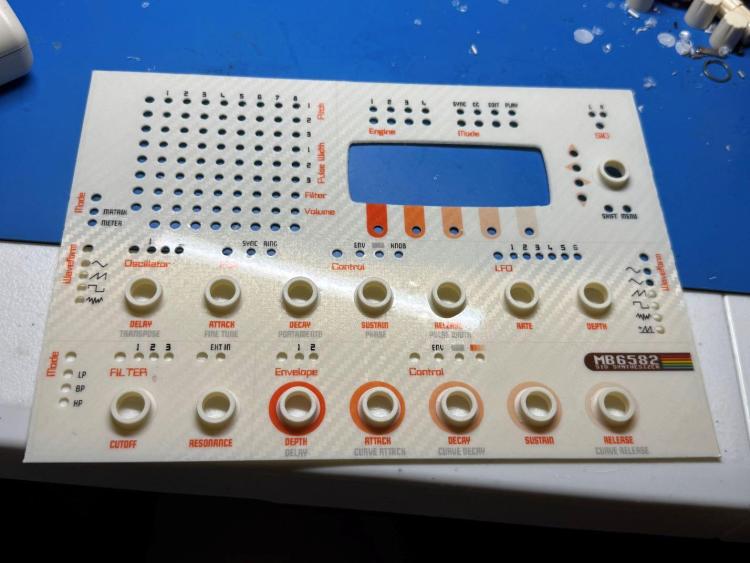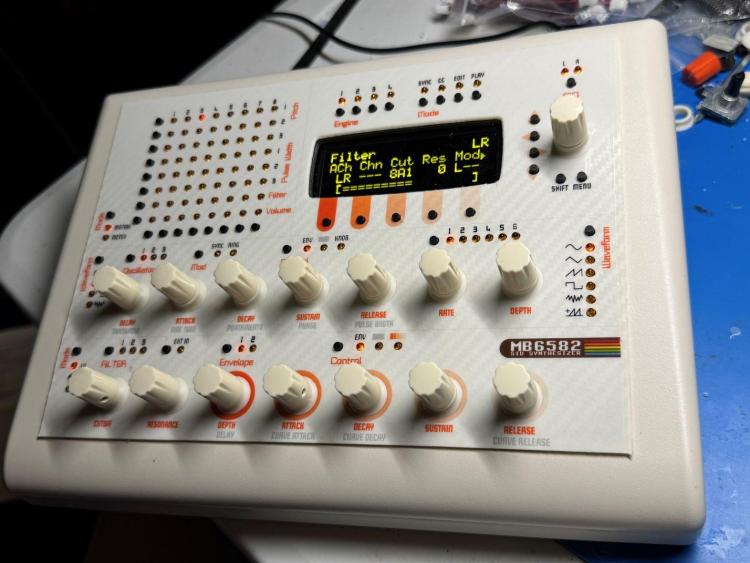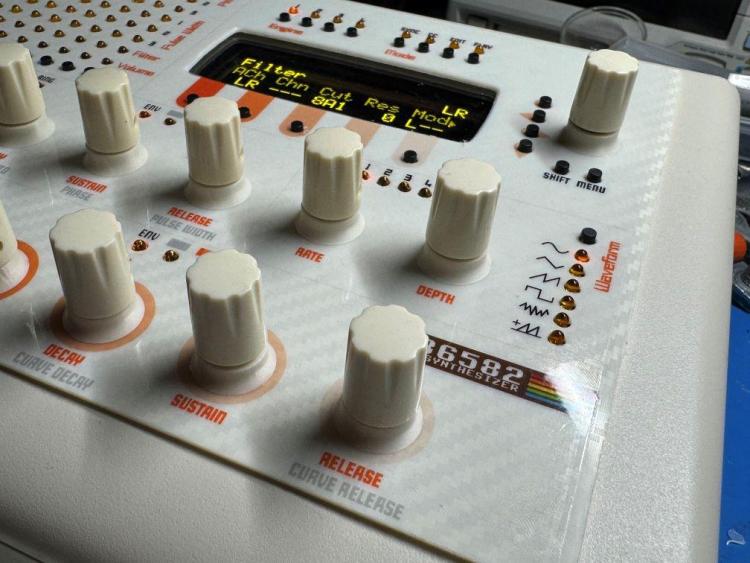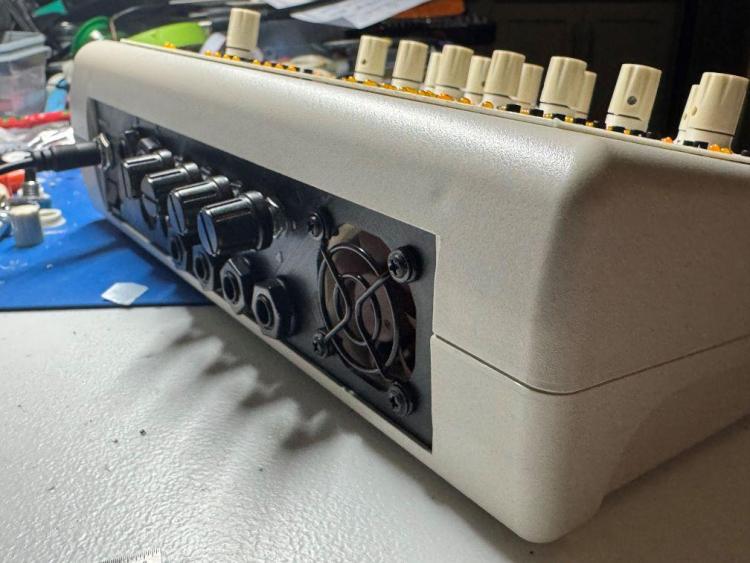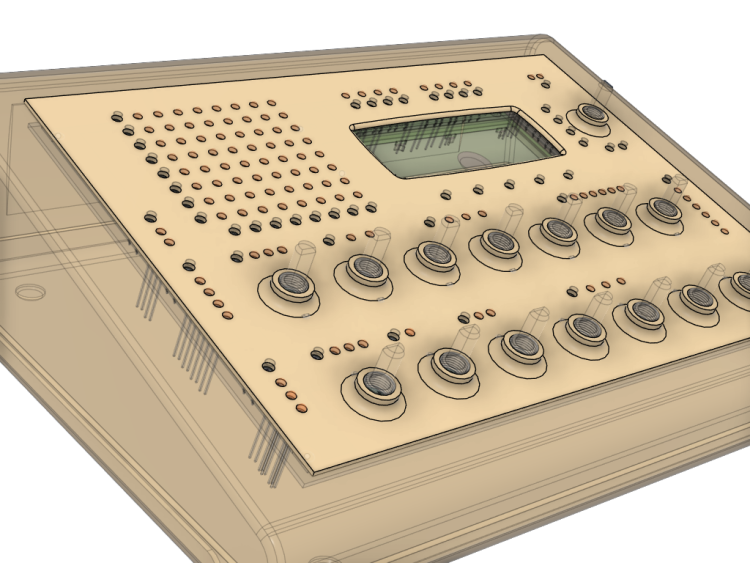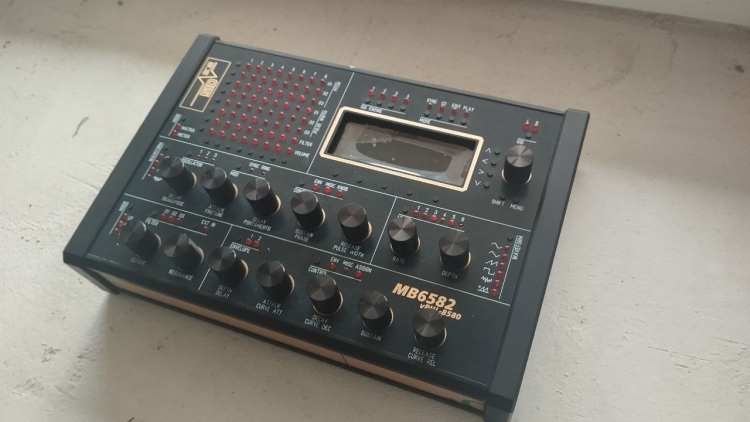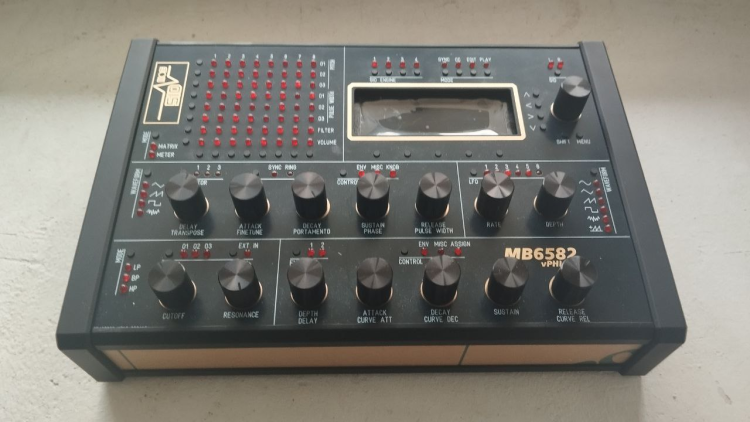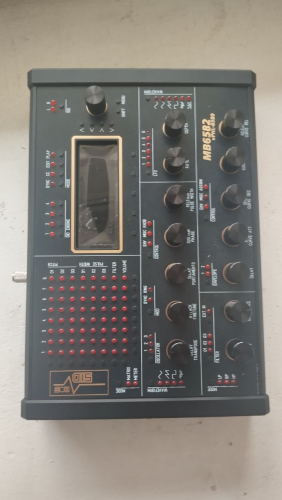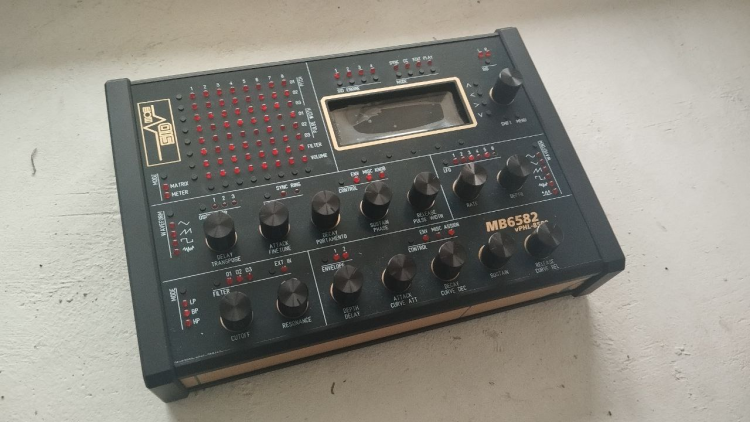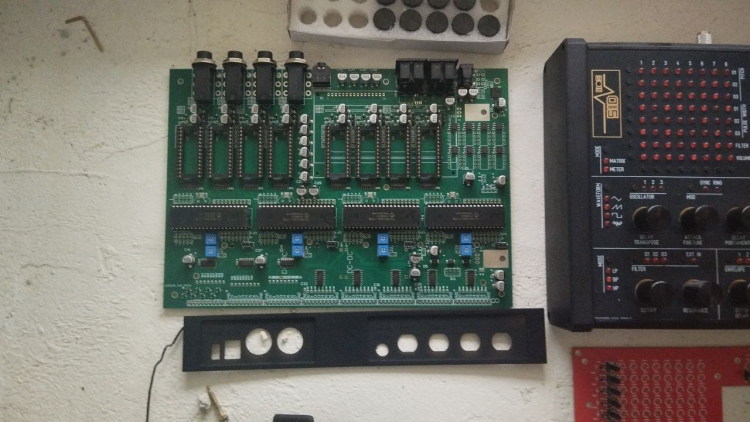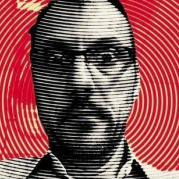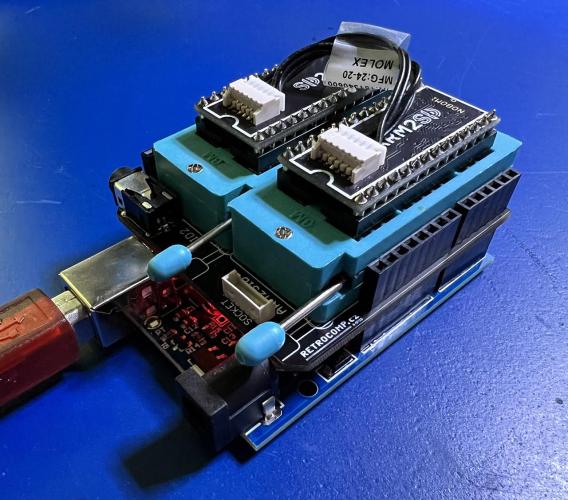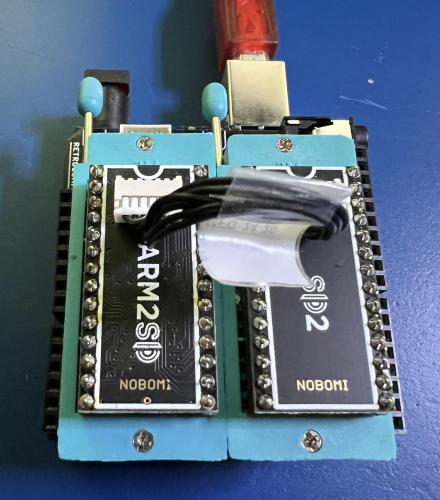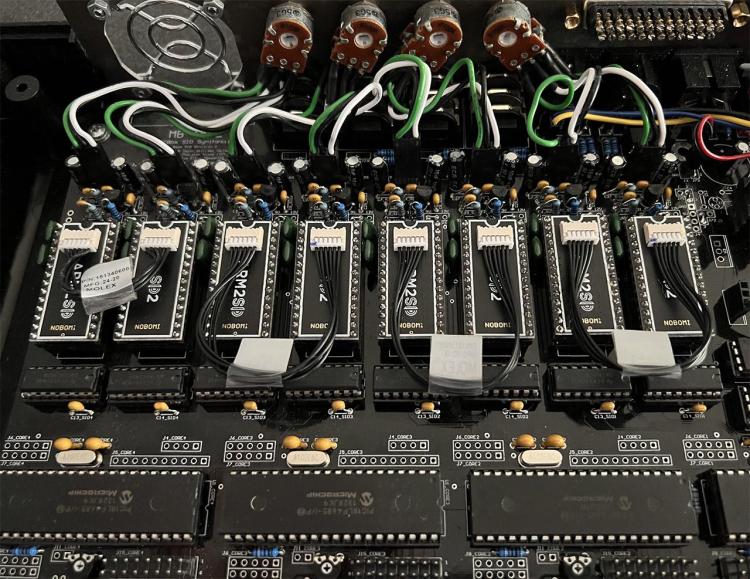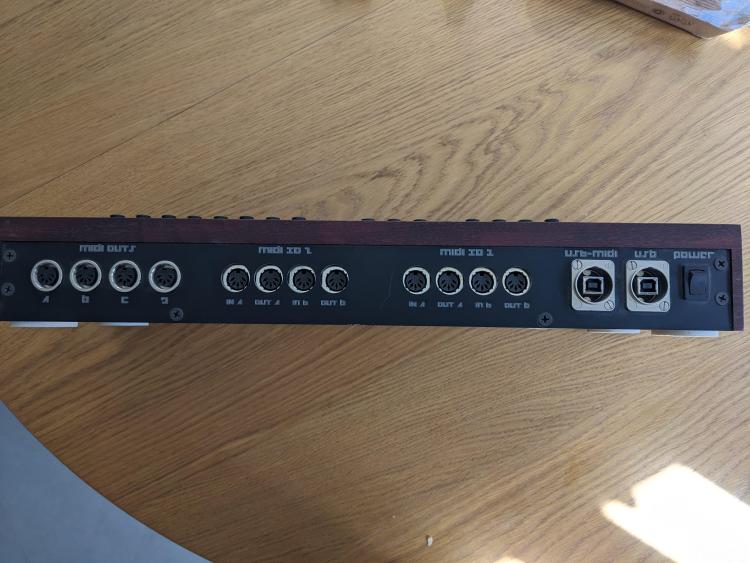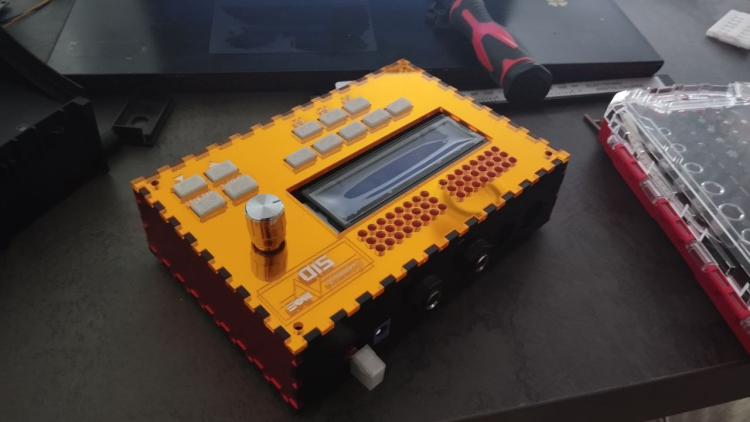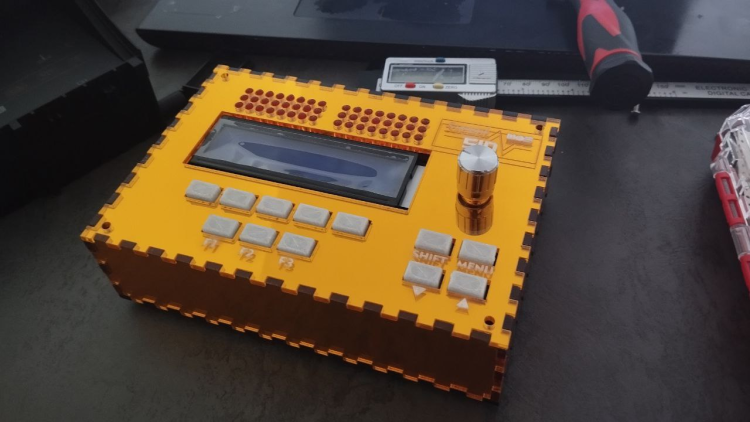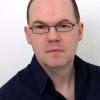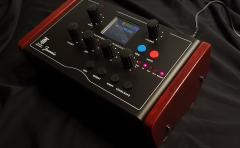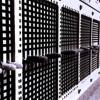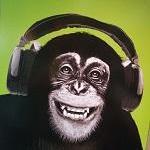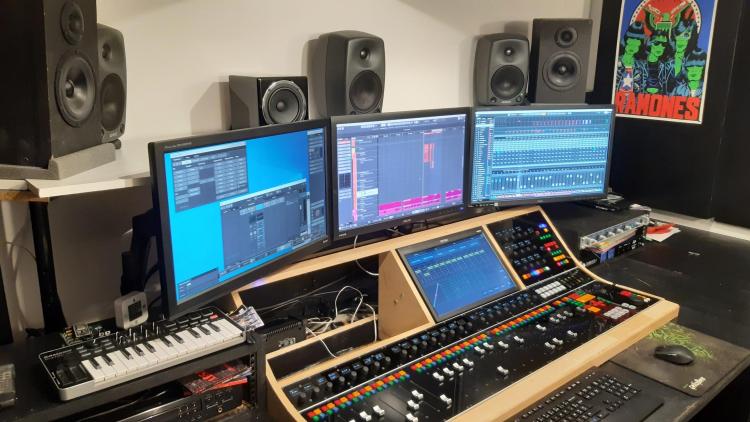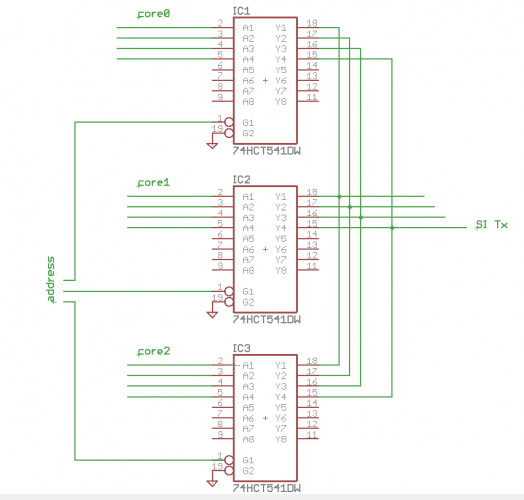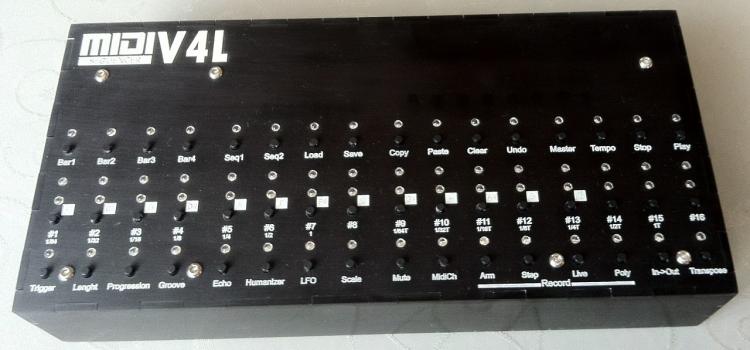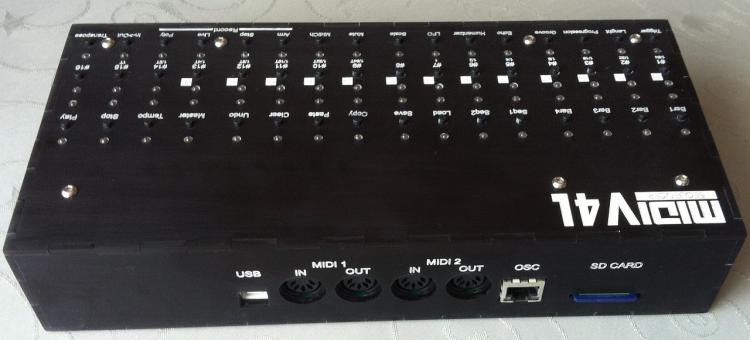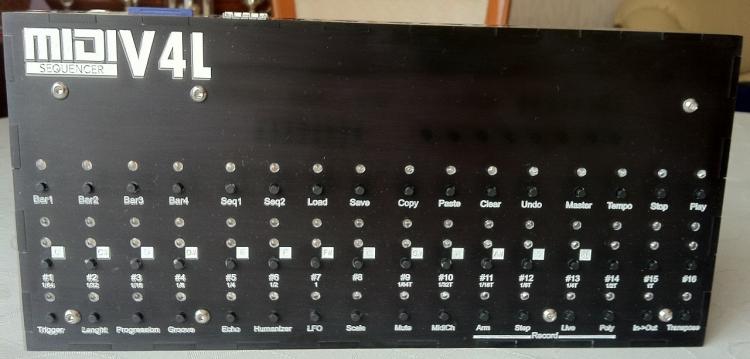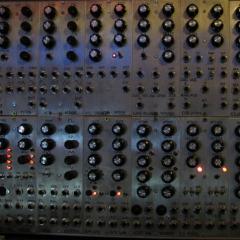Leaderboard
Popular Content
Showing content with the highest reputation since 12/04/2021 in all areas
-
Hey everyone, just wanted to share my latest build since I'm sure there are some 3D printing enthusiasts here like myself. I bought the parts for an MB6582 about 5 years ago, if you remember Meeblip was selling those 8580 SID chips and I picked up 8 of them, and then put everything into a box in a closet . 3D printing has come a very long way since the original MB6582 was created by Wilba. I read that the JB Weld solution may or may not be holding up great after all this time. Also, I wanted to use a Newhaven OLED which is much thinner than the original LCD. I thought there must be a solution to lower the gap distance so why not create some type of spacer for between the front panel and the PCB? I designed all parts in Fusion360. The PCB screws directly into the spacer using M2.5 nuts/screws and plastic screws. The top of it has a flange that rests in the panel groove for the PT-10. Total spacer height is 5.7mm which is the height of the base of the encoders. The front panel is another 1.25mm. Everything is printed out of ASA, which is very strong and heat resistant. I designed the panel graphics in Inkscape and printed on translucent vinyl. I used Davies knobs with small printed skirts to cover up the threads of the encoders since they were exposed. I do not have a vinyl autocutter but I do have an exacto and lots of patience Overall tried going with a 80s beige computer look. A build plate for my printer created the carbon fiber effect on the panel. I'm happy to share the 3D files if anyone could use them.3 points
-
I read a lot of guides. Successfully compiled ASM code. The OLED display works well with an 8bit driver. If anyone needs the firmware, here is: setup_sammich_sid_8bit.hex3 points
-
Hey man. It's actually an FR4-Standard PCB. Non aluminium. But seems pretty robust anyway.2 points
-
2 points
-
2 points
-
Hello everyone! Over the past few months, I’ve engineered a brand-new MB6582-style synthesizer, deeply inspired by the original Midibox MB6582 but redesigned completely from scratch for improved reliability, easier assembly, and modern component availability. Key new features: Premium ENIG front panel PCB - durable, professional finish 4 PIC cores onboard - full MB6582-compatible architecture Factory-manufactured PCB set, including the front panel Supports ArmSID, Kung Fu SID, or original 6581/6582/8580 chips Clean internal layout, solid build, and high-quality components Prices: Base unit: 420 EUR + shipping With Kung Fu SID set: 499 EUR ArmSID pricing available upon request. Availability: The license allows producing 10 units, so I’m offering 9 units for sale. 1 unit is in stock right now Additional units can be assembled in 3-4 weeks If I receive permission to sell more broadly, I plan to lower the price and release all design files as open source I will make a separate thread in Latest News or somewhere else Photos PCBs and components:1 point
-
Hello how much will cost the mb6582? and also If you plan to build a sammichFM let me know1 point
-
In an older post (referenced below) there was a lot of talk about the different SID clone options available and the pros and cons of each. Somewhere in that thread I put my own cards on the table and doubled-down on the ARMSID, because IMHO it provides very good sound emulation for my synths and my Commodore systems. Well, fast-forward to today (a couple years later), and I'm still happy to say that I use the ARMSID and ARM2SID regularly. In fact, I did a quick inventory check and realized that I've purchased about ~25 of them over the last 2 yrs, for various builds and repairs... In that same older forum post, I made a reference to the ARMSID Shield, which is an Arduino Uno add-on, that lets you test and configure your ARMSIDs, as well as manage firmware updates and even play some SID tunes to test everything out. This shield basically lets you do everything with the ARMSID that you would have needed a C64 computer for in the past. I thought it would be useful for anyone that is thinking about using the ARMSID / ARM2SID for their MIDIBox SID builds, to have a quick and handy reference to help them get setup. https://docs.google.com/document/d/1B_xzXlLjq3NbKnOrhIoJ5PrlVIhlsD_aASEhB0CWK90/edit?usp=sharing Questions & comments are welcomed... Cheers1 point
-
From what I gather from the manual and changelog, this LED indicates whether you have selected a „positive values only“ waveform for the LFO (instead of applying the default workaround by showing waveform LED + Random LED). It does not indicate that the value of the LFO is currently positive.1 point
-
Prompted by a message from freddy, I've attached the project files below. They contain the source and the binaries for the bootloader and the main code. 1.05 is the latest version - there was a fix in the bootloader and the main code. I included some memory in the final hardware design but never got around to doing anything useful with it. I had plans to save one or more demo tunes as MIDI files and perhaps save some settings as profiles for different scenarios - my interests had moved on before that happened. You can find more project info at https://web.archive.org/web/20210206041027/http://www.grapevyne.com/pic.projects/ - the documentation links are all active so you can download the magazine articles and also my original source for the articles (a few errors crept into the magazine article during editing). mistralXG project files.zip mistralBoot.zip1 point
-
To use Studio on newer Ubuntu Desktops you need to install the old libwebkit2gtk-4.0.so.37. To do so create a sources.list file for apt containing the following line: deb http://gb.archive.ubuntu.com/ubuntu jammy main And install the lib. sudo apt update sudo apt install libwebkit2gtk-4.0-dev After this delete the sources.list file. More infos on https://www.weigu.lu/music/midibox_hp_2x2/index.html1 point
-
Reflowed the ttasnsistors on the top side and now I am back to 12 LEDs on. I'm assuming the LEDs shouldn't be on, but otherwise that feels like an improvement as it means I get mattias switch events for 12 of 16. I'm also getting events for depresses on the right 4 encoders although they seem a bit random in the actual event details. I've also replaced IC2, IC3 and T3 based on advice from ChatGPT but that made no difference.1 point
-
Thanks, perhaps I'll shoot over to the UK ;-) I've rebuilt the core board now and I'm back where roughly where I started. At least I feel confident I have eliminated the core as a possible cause; the problem must be with my LeMec board. Done some more reflowing on that board and now: - just 4 LEDs light up on power up now - all encoders generate counts when rotated but not depresses - botton left 4 buttons generate no events; bottom right four are working - mattias switches generate events for the four that have illuminated LEDs but not the rest1 point
-
With velocity bars there is more info displayed and the spacing is more uniform. The hyphen/minus as a spacer for natural notes helps to connect them; with spaces it is more confusing. Do you really use those low octaves so often @anonyme-x22? If it bothers you, a workaround is to transpose either on the SEQ or your synth.1 point
-
Hello, When i mute part, i can do it by bottom row (normal known behavior), but also the top row. So it's confusing. Being able to mute only on bottom row will make the workflow more consistant. Or it could also being interesting to be able to mute differently between upper and bottom row. Like top row track 1-16 mute. Bottom row group 1-4 mute. Thanks in advance, Have a good day, Rgds,1 point
-
MB-6582 SOLD Selling these as I no longer use them. I assembled the MB-6582 myself. It has 6x 8580 SIDs installed, and could use some TLC: - The encoders occasionally skip counts when adjusting them. I think this is just down to a bad batch so replacing them should fix it - Some of the standoffs that attach the front panel to the CS PCB have come unstuck and need to be reglued The SEQ V4 works perfectly €500 for either unit I am based in Spain1 point
-
Hi Niles, I still have original mb6582 encoders, bulk ordered and sent by Wilba. Working perfectly! Would you like some? Best1 point
-
Arrived and kicking. Thank u for your service ❤️1 point
-
1 point
-
1 point
-
Just a small necro-bump :-) …by now we are roughly 150 people over there with some occasional chatting going on. Feel free to drop by!1 point
-
maybe its the Ripple off the PSU about your PSU - reichelt specs is saying : "Ondulation résiduelle : 80 mVcàc" i guess this is not a 50Hz ripple but HF ripple... --- i guess some small cap (100nf, 10pF) and a big Cap (depends on the load, use for example a 100uF and a 2200uF) on the output off the PSU would reduce that "ripple"... * maybe that caps are not enough and you need some more filtering (coil, resistor, lpf...) but i would start with some caps... the connections in your 2nd picture are not necessery - i guess (dont seeing the whole picture, but i think so...) --- so picture 1 is correct. by the way - its only the last LED that flickers? maybe you have to terminate the DO line on the very last LED off the Chain with a 10K resistor to 5V or Ground. else it could be a software problem, when the software loops thru the LEDs, and when it comes to the last one it jumps to the beginning off the chain... try to programm in the ng code one more LED (which in reality not exists) - so you can be sure that this is not a software bug... - but dont ask me about ng-programming --- no glue about that. - mike.1 point
-
1 point
-
1 point
-
Hi Long time I don't play with NG config, but It should be possible with enc_mode=Inc41_Dec3F , combined with fwd to 2 sender and conditional filtering, something like if_equal=0x41 send note A, and if_equal=0x3F send note B ?1 point
-
@ Faderboard 1 & 2 Mounting holes labeling not necessery again. rest is ok. you may could label + and - beside the 2x5 shroudet Pinheaders, so there is no chance someone reverse it in a way... in generell... normally the Nose- says all, but someone could crimp the cable incorrect... so if he controll measure, this is a good hint then for him.1 point
-
That's absolutely glorious Peter! Nice work (as always!)1 point
-
Yes, absolutely. Please PM me for details, ideally including your location so I can give you a shipping quote if interested.1 point
-
Looks very nice and neat .I didnt know you are so busy with things . (Thank you for your support). I was working a lot with max/msp and m4l too. Its a lot of fun , but it takes a lot of time as well :) . Enjoy and keep up this amazing work.1 point
-
So good and inspiring to see what you are creating! Good luck with your further progress, I‘m watching you :-)!1 point
-
look into ng documentation if there can be set a offset for the middle position so it stays on a position... because pots directly to the core is always a bit random... better use for example: http://www.ucapps.de/mbhp_ainser8.html then you have less random values also check the quality off PSU...off course a faulty pot can be the reason too1 point
-
@ cherry: the switch itself you can get already from eg https://www.reichelt.de/tastaturzubehoer-c8099.html?ACTION=2&GROUPID=8099&SEARCH=*&START=16&OFFSET=16&CCOUNTRY=445&LANGUAGE=de&r=1&SID=967792150a00d890464504461a66ae529d97182e528c945af4544 caps: amazon, alibaba,.maybe.some thing like that: https://www.amazon.com/dp/B00FYO8EDC/ref=mp_s_a_1_5?keywords=flat%2Bkeycaps&qid=1675511770&sr=8-5&th=1&psc=1 https://www.cherrymx.de/en/dev.html the low profile is maybe interesting....1 point
-
control hardware yes, if it is well documentadet on the wiki (shematic, board screenshot) I too work with kicad since decades... and very sucessfull now with my actual projects - i was wondering but i planed it in kicad, and most off the boards where working 100% out off the Box (pick and place JLCPCB), ok i had a design fault on one, but that was solved with a wire-done. actual projects http://wiki.midibox.org/doku.php?id=triggermatrix5 http://wiki.midibox.org/doku.php?id=daw-ableton http://wiki.midibox.org/doku.php?id=openpad software: cant help, write my own Mios-based code, havent look into MidiboxNG - since it is a script, for me more easy to write it directly in C, (need to understand all, else i understand/learn nothing...) - so no help from this side had good expierences with jlcpcb... also with the Pick and Place service FrontPanels: maybe cheap CNC-Laser-Cutting from pcbway? https://www.pcbway.com/rapid-prototyping/CNC-machining/CNC-Laser-Cutting-Services.html suggestions? Maybe use Eurorackformat, so it can be used outside of your box too? suggestion, where usefull (wo sinnvoll) use J89 Serial Chain directly onboard (like encoder with ledring boards) to reduce wireing - a simple button board dont needs that of course.... *** if you go the Serial Chain way, then buffer the Serial chain on each module to keep the digital Signal Quality intact (very necessery) *** buffer: search for SN74LVC1G17DBVR in this shematic: http://wiki.midibox.org/lib/exe/fetch.php?media=phatline:blm16x16-shematic.pdf maybe use pick and place ready smd technologoy like i did: that makes it smaller, and less to solder, less to debug, the plastic packages stays in china, more economical special when ordering more pcbs, by that of course a module should fit all the boxes (a exotic 1 man needs it module 10times fabricated is 9 too much...) i think i dont have to say, that you should choose "Basic" Parts, and not "extendet parts" on JLCPCB, - off course on most modules you have at least one or two extendeet parts... but for example a DINX4 or DOUTX4 can be made with basic parts only... but when you also want to pick and place all the pin headers - these are extendet parts, how ever ... you may look on my last modules a bit http://wiki.midibox.org/doku.php?id=tm5-dindoutgate http://wiki.midibox.org/doku.php?id=doutx2dinx1 if you use long cables to your Displays + u use more displays then one - on the modules, use a display driver (no more walking lines) http://wiki.midibox.org/doku.php?id=displaydriver-smd what else? if you make ground or other PCB-Planes, then setup kicad that it make 1-2mm space arround solderpoints - else the Soldering Man could make shorts, or electrocemical oxidations or solder flux-low-residance could make there some problems (after years), special when the Solderstop-Pain is scratched a bit... ... and so on... PS i hate this wooble feeling off this LeMec Buttons (the last board you posted) - these Buttons are not good (for my taste) I love to work with this ones: https://www.reichelt.de/at/de/eingabetaster-schaltspannung-24v-fuer-led-sw-dtl-2-sw-p7248.html?&trstct=pos_0&nbc=1 they are expensive, but they last decades (in use, and also if you order 300 off them and let them lye arround, after 15 years they still work) They have good CLICK, like a mechanical Keyboard. your leMec Buttons are like a mixture off Rubberdome and "i have to touch this buttons into one direction X=0 Y=0 else it want switch" or you could use: https://www.midiphy.com/en/shop-details/140/4/5pcs-matias-quiet-click-tactile-switch- they are cheap but big... (aka take away a lot of Frontpanel space) or maybe you use cherry switches or simulars.... they are all 1000% better then this leMecs... ( you notice i hate them)1 point
-
this will take a while - look into the forum in 5 weeks or so. i need the PCB to make a new version off Triggermatrix (http://wiki.midibox.org/doku.php?id=triggermatrix4) the Frontpanel is not a generic MatrixController thing - it has 17 Displays, 8 Faders, some rotarys and buttons, the Software for this is not a normal Midicontroller-code (aka Midibox NG) - its my own creation a sequencer based on MIOS. - but if i not make a shematic mistake, the pcb should be usable like the orginal BLM16*16+X in other Midibox Projects.1 point
-
1 point
-
Did you adjust the bootloader for the SSD1306? See here http://ucapps.de/midibox_ng_manual_lcd.html1 point
-
pcb arrive, soldered 4 off them (12 channels) - the 4 others i make a nother time. (24ch in total) the display drivers from Andy work great again! the midibox code is working, the max for live patches too. (at least for this state i am happy to get automaticly the Channels names, and the Macronames!!! hell yeah!)1 point
-
Here's the gerbers for the MB-6582 panel set pictured in this thread... Please credit @listen202 and @Manu29 for their efforts... _MB6582_Panel_L202-Manu.zip _MB6582_Rear_L202-Manu.zip1 point
-
Notwithstanding a possible bridge day, last Friday of the month (27.05.22 / 7:30pm), online: We organize our regular Open Hardware Happy Hour (O3H) again! This month’s topic is Open Music, since Open Hardware is of course also a topic in the field of electronic music devices (and more and more on the rise). Among other things, we will present the sample sequencer by SucoFunk, The beatmakers’s sketchbook, an Open Hardware device that was also featured at this year’s Superbooth. We have asked for other speakers, so be prepared to be surprised, and bring your own (music) projects! Presenters will include Marc Berendes, Berlin-based Open Hardware developer at SucoFunk. Marc Berendes: The beatmakers’s sketchbook – An open sample sequencer for beats on-the-go (https://sucofunk.com/) (tba) Language of the presentations will probably be German this time. Link Call: https://bbb.cyber4edu.org/b/dan-gi4-bxg-p1v Blog: https://hardware.prototypefund.de/o3h-meetup-zu-open-music/1 point
-
Hi Therezin, I mounted the monitor upside-down because of the viewing angle. This specific monitor has been designed to be looked at from above. It's actually pretty good from around 10° to 90°, but from 95° to 180°, the visibility is very bad. Therefore i had to reverse it so when i seat behind my desk, i'm in the good range. Let me know if this explanation is not clear enough, it's pretty hard to describe in a foreign language. Thomas1 point
-
1 point
-
Hi ssp, Two things: First, you need to change the id of the second controller: # Bank 1 EVENT_AINSER id=1 hw_id =1 bank=1 fwd_to_lcd=1 type=CC chn=1 cc=16 range=0:127 offset=0 lcd_pos=2:1:1 label="FDR1 #%3i %3d@(2:1:2)%B" #Bank 2 EVENT_AINSER id=1001 hw_id =1 bank=2 fwd_to_lcd=1 type=CC chn=1 cc=17 range=0:127 offset=0 lcd_pos=2:1:1 label="FDR2 #%3i %3d@(2:1:2)%B" Otherwise, Midibox might get confused, all EVENT_xxx must have a unique id. Unless they are of different types. for example you can have EVENT_LED id=1 and EVENT_AINSER id=1 Second: To light an led for each bank you need the button that sets the bank to forward info to the respective LED. for example: # select Bank1 directly EVENT_BUTTON id=1 fwd_id= LED:1 type=Meta meta=SetBank button_mode=OnOnly range=1:1 # select Bank2 directly EVENT_BUTTON id=2 fwd_id= LED:2 type=Meta meta=SetBank button_mode=OnOnly range=2:2 #LEDS EVENTS EVENT_LED id= 1 range= 1:1 radio_group= 1 EVENT_LED id= 2 range= 2:2 radio_group=1 The radio group makes sure only one LED turns on I also put the switches in the same radio_group on my config, but i'm not certain it's mandatory. now, i didn't use cycle_bank, inc_bank or dec_bank but you can take a look at those examples config to see if you find something interesting: https://github.com/midibox/mios32/tree/master/apps/controllers/midibox_ng_v1/cfg/tests And also, i found usefull to add #initialize all banks to 1 log "call bank 1 for all parameters" set ^bank 1 to the section 0 of my .ngr script. this ensure that all parameters are set to bank 1 at startup.1 point
-
Hi everyone! Quick update here. I finally finished my controller and installed it in my small control-room. Here it is. I really like the way it turned out, i'm working with it since 2 weeks now, and it's a real bonus to the ergonomics. It still have room for improvements but that was expected and i will continue to work on it in the next future. I'd like to thank everyone on this forum who helped me build this and a BIG thanks to TK and all the midibox team. Without this place I would have never been able to even start this project. Cheers, Thomas1 point
-
It's not quite clear to me what you want to do? You want to have one J89 SRIO chain and switch between several Cores? If that's right, it is trivial to make a Johnson counter/decade counter out of a 4017 chip. You could think to use the output enable pin(s) of the buffer (541 or 125) that is used to interface the buss to the core. Each Core gets one buffer with the datalines connected to the inputs (+DIN to an output), the outputs are common to the J89 chain (+ the serial in). Advance the counter to "turn on" one chip.1 point
-
I get the same, but one trick is to highlight the entire contents and "print" the page to PDF. Then you should get the images in line. Best, Andy1 point
-
Quick heads up on this for anyone that might wanna do this. I had some trouble compiling the above version for Linux Mint 19.3. Couple things you might need to do: ./configure --without-residfp This was giving me a weird "you need to be on a 32-bit platform at least" error (I'm on 64-bit, Ryzen) but we don't need this for outputting to an MBSID anyway The makefiles do not add -pthread. There's probably a more elegant way to fix this, but I just edited src/Makefile and added `-pthread` to the end of CFLAGS, CXXFLAGS and that seemed to avoid the errors You may need to symlink /usr/local/lib64/vice to /usr/local/lib if installing system wide (otherwise stuff like keyboard input doesn't work) You need the ROMs of course! Doing all this allowed me to bust out the HVSC intros included in the collection. Seems to work like a champ!1 point
-
1 point
-
for those who don't find a sd card socket for the core stm32F4. you could use micro SD card and the ADAPTATOR will be the socket like:http://www.ucapps.de/mbhp_sdcard.html first solder unused component legs to the adaptator: solder to the core but leave some space to the board for avoid short (be carefull pinning): you could fix it (glue) if you want (not done for me legs are sufficiant) et voila!1 point



